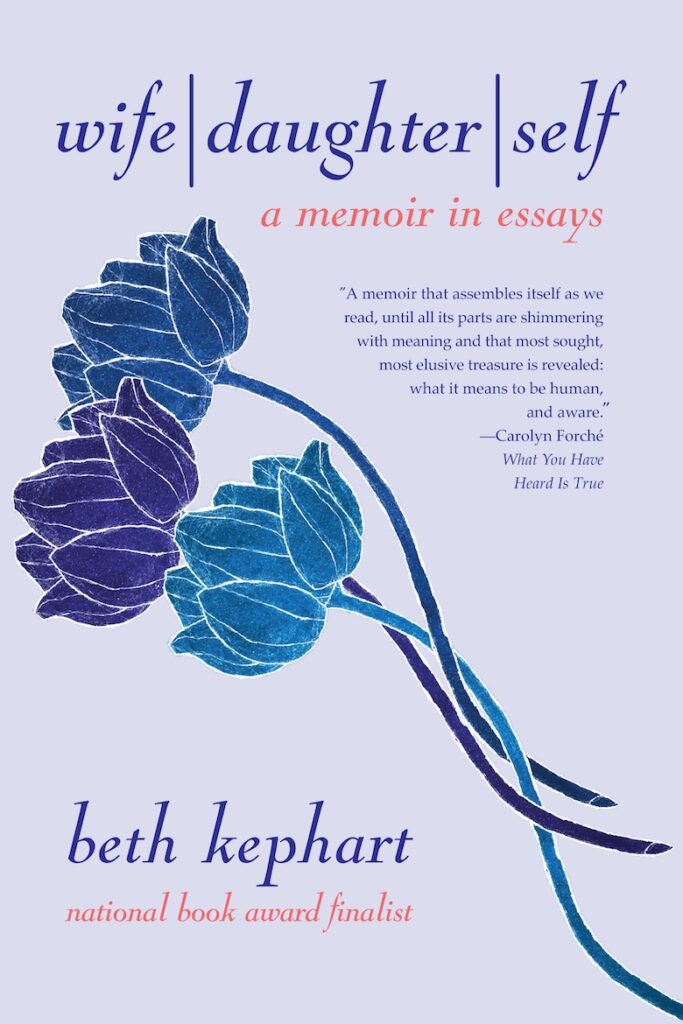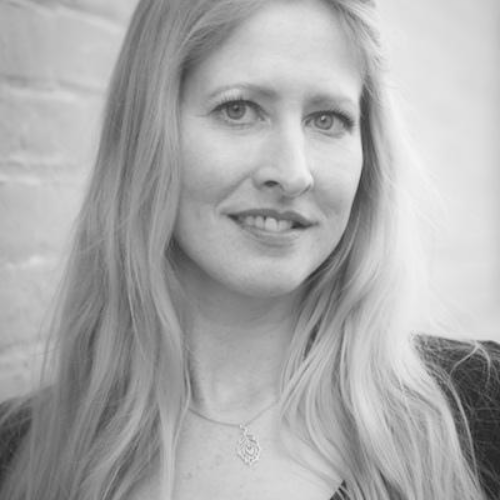Reviewed by Angela L. Eckhart
 Beth Kephart is a lyrical wordsmith, and she’s penned a unique and creative memoir in essays. “Memoir is the adapted and adaptive truth,” she says. “Memoir is the life wanting to be transformed. It is the life we have been waiting for.”
Beth Kephart is a lyrical wordsmith, and she’s penned a unique and creative memoir in essays. “Memoir is the adapted and adaptive truth,” she says. “Memoir is the life wanting to be transformed. It is the life we have been waiting for.”
In Wife | Daughter | Self : A memoir in essays (Forest Avenue Press, March 2021, with illustrations by William Sulit), Kephart explores her identities of wife, daughter, and self in three sections. Each section contains a preface, followed by mini essays, mostly written in poetic prose. The essays are not linear or chronological; rather, they are snapshots of memories she recalls and examines hoping to unearth deeper meanings.
We begin with the section WIFE where we are shown time spent with her husband, Bill. The poetry of her words brushes across the canvas of her readers’ minds, painting detailed and colorful scenes. For their 33rd anniversary, Kephart and her Salvadorian-artist husband rent a cottage at Lily Lake, which is also the essay’s title. She describes their first night with alliteration: “…it stormed a mighty storm. From our tree-top perch in a screened-in porch we watched the big trees bend and the pale pinks pop and the lake bruise up and dimple.” Reading sentences like that aloud are fun and pleasing to the ears.
In “Double Parentheses,” she describes her husband, his art success, her own yearnings, and rejections. She admits her declarations and innermost fears. She writes in the third person: “There are no words for how you love this man, for how your hopes for him have been achieved. You loved his talent first. You loved it more. You hope that he will not love you less, for all that you now are not.” Her self-doubt peeks through, and we see her vulnerability. Again, while she is proud of his success, she desires the same for herself.
And then Kephart and her husband decide to do something together. They create a writer’s workshop in the form of a retreat on a working farm in Central Pennsylvania, an oasis away from the current political landscape. In “A Shelter for the Truth,” she writes, “It is 2016, and the news of the world is bad news. The man who will too soon be in charge of executive orders and public discourse is a triumphant liar.” This opinion momentarily pulls me out of the reverie of the story because who isn’t a “triumphant liar” these days? But the premise for this getaway is to “build a raft,” and I want to hop on and float towards a respite, too. They create a temporary haven together, united. She teaches memoir with writing activities, and Bill instructs with photography to teach them “something more about who they are and what they are capable of, how they see.” The focus is seeking one’s truth through art. While observing her husband, Kephart views him with the eyes of others, and she offers her sentimental feelings: “I see Bill as someone new. I see him as these women do, as someone still apart from me, as someone I will fall in love with again, doesn’t matter that he already has my heart.” And this essay also becomes a love letter to her husband.
In the DAUGHTER section, the essay “Cut The Light” recounts when the time in 2016 when she and her father are selling her parents’ home, which they had built in 1973. After going through the house the final time, the realtor finds tins her mother had hidden under a sink. This discovery is filled with memories of her mother, and Kephart shares the treasure with her siblings, realizing her mother had the last word.
Kephart writes of her relationship with her father and things unsaid in “Family Resemblances.” She explores how our relationships, or lack thereof, form who we are and who we can become, something to which many readers can relate. In “Breakdown,” the enigma of her father’s illness, his mental fog, and the insistence he’s a virus permeates his understanding and capacity to function. She encounters a transformation within herself while fighting for her father’s life and his well-being. “When fighting on behalf of someone you love, the fight must end, the love must be the art of being present.” There are some lessons to learn here, through Kephart’s experiences.
In later essays, Kephart divulges her anxiety, admitting she ignores triggers that bring on panic attacks. In “The Weight of My Confessions,” she confesses to her father of writing a story about her mother and him. He’d said it was good: “A book like that could be important.” His mild approval is a sigh of relief.
In her final section, SELF, Kephart narrates her essay, “Second Coming,” in third person. It is full of forgiveness of one’s self and a chance to start anew and nurture that passion within. She conjures random childhood memories, specific places, and items, such as falling from a swing and breaking her wrist or trying to save the dying bird nestled amongst the berry patch. The images and vivid details bring the scenes alive, and readers may feel like they are witnesses.
After learning to write and encouraged by a family member, Kephart had filled a blank book with paint and words, only to dispose of it after being knocked down by college roommates who thought her poems were bad. Like many closeted artists who work in business, she had “become strategic with the real, become, like your father, business minded, forge ahead, unembellished, entirely pragmatic with all your matters of fact.” She had lost her sense of self, and this remained dormant until she met her future husband, an artist who reawakened the creative writer within her.
How often does this happen to artistically like-minded people? Without stating as much, Kephart has achieved success, maybe not to her standards, but accomplished and widely read, all the same. Her lyrical discourse in Wife | Daughter | Self is simultaneously engaging and enchanting while also becoming an example of crafting personal essays into a memoir, echoing her “belief that truth is not continuous, that stories live in seams, that we remember in bursts and find wisdom in the juxtaposed….”
In her acknowledgments, Kephart states, “Memoir is a fixative. Put the life on the page, and there the life is. A memoir is never right. Nor is the memoirist.” Yet writing memoir is finding meaning and truth and making our lives, our personal selves, matter. Kephart has found her way in her artfully crafted prose.

Angela L. Eckhart
ReviewerAngela earned her M.A. in creative writing from Wilkes University. She’s edited two books for local authors and worked as an adjunct writing professional at her local community college for two semesters. She has completed a novel, is currently working on a memoir, and has been reviewing books for Hippocampus magazine since 2011, where she previously served as Book Reviews Editor for several years. She’s a staple volunteer at HippoCamp, and she’ll be participating in the Belize Writer’s Conference, as well as her bi-annual writing retreats.


